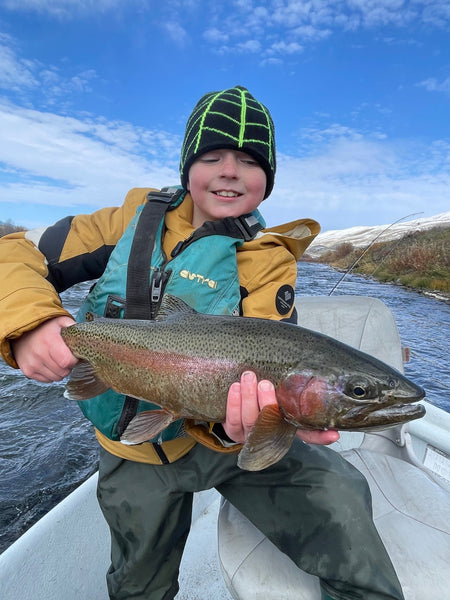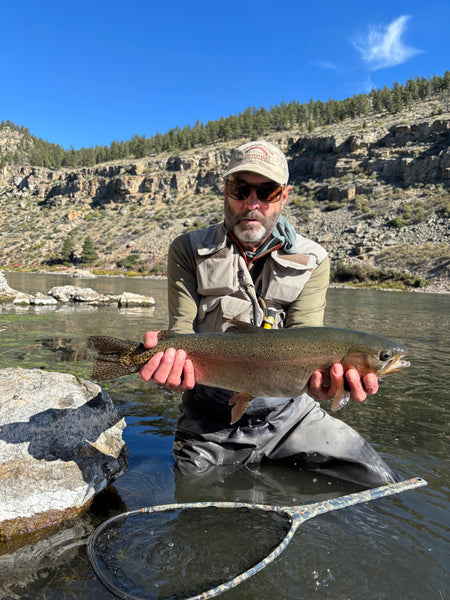Wade Fishing the Upper Madison River during Run-Off
By Jake Schilling - 01/07/2020
Wade Fishing the Upper Madison River during Run-Off

Throughout April and May across Montana, snowmelt run-off begins in earnest and changes our rivers dramatically. From the higher and dirtier flows emerging you can find yourself looking at a totally different river than the week before. Some rivers completely blow-out to the point of fishing being nothing more than casting practice, or a nice walk with the dogs. But thankfully for us on Upper Madison, run-off means the start of great fishing, if you know what to look for. If you pick up anything from this short blog, don't let the dirty water scare you off.
Generally, the Upper Wade section (Quake Lake outlet-Lyon Bridge) runs at around 900-1,100 CFS during winter months, this is dependent on how much water Hebgen Dam is letting out based on snowpack. In a great snow year they will run the dam at a higher outlet to make room for upcoming snowmelt, and vice versa on lighter snowpack winters. Once run-off arrives, the flows can quickly jump to 2,000-3,000 CFS over a week’s span. Once run-off starts you can count on flows changing from clear to green, to milky green, and then full-on chocolate milkshake status. The optimal color is anything with green, but they'll still eat fine when brown. Also important to keep in mind that your best fishing is usually going to be the middle of the day (12:00-2:00), water is cold and needs to warm up a bit.

Techniques
Euro/Czech Nymphing
If you haven't Euro nymphed the Madison during run-off (or at all), take some time this spring to give it a try. As most of the fish will hug up to the bank and nearby pockets, this is an excellent short-range strategy to fish their water efficiently and effectively. One huge springtime tip that gets overlooked- make sure to fish the water directly off the bank before even thinking about stepping in. Remember that in dirty conditions the fish will have a harder time seeing you, as long as you aren't too disruptive you can get damn close. Stick with a variety of Stonefly patterns like a #10 Golden Biot, I really enjoy using a matte black tungsten bead.
Right here would be a good time to mention spawning fish. Hopefully, most Rainbows are finished up by runoff, but if you are able to see the bottom, please keep your eyes peeled for spawning beds. There's not a whole lot more to say than this is very unethical and should be avoided at all costs.
Swinging
Whether you prefer soft hackles or steamers, single or two-handed, make sure to have them handy in the truck. As spring Baetis, Skwala, and March Brown hatches develop, you can keep yourself busy swinging soft hackles. For location, really focus in on the soft insides of long runs, island tail outs, and gravel flats where you would post up and throw dries mid-summer. Sculpin and bugger patterns get it done too, besides the locations just mentioned, swing back towards softer banks and make sure to let your fly hang at the end of your swing, as with nymphing you'll find 'em tight to the bank.
Dries
As long as the flows aren't at their run-off peak (2,500-4,000+), you can find rising fish in the slower-paced spots that you would headhunt in July. That being said it's wise to spend a lot of time inside channels, those tend to be the most reliable water for risers. Besides Baetis, Midges, and March Browns, keep your eyes open for Skwalas. These stoneflies generally come in around #14 and are an olive-brownish color. Skwalas tend to be very hit-or-miss in my experience, you can have surface looks all day, or none at all. I don't use a dry fly and nymph "Hopper-Dropper" set-up very much, but will during Skwala season. Make sure to have an appropriate length on your dropper, the Madison is pretty swift and a 24" dropper may only get you 12'' down into the water column, tungsten beads help.
Access
If you have access to a boat, definitely take advantage of the Upper Wade section by using a boat as a means of transportation. Keep in mind you cannot fish from a boat in this stretch (Quake outlet-Lyon Bridge), you must park and get out. It's a blast to float, hop out and wade fish a spot for a few minutes, hop back in and float to the next spot. It's also a great way to spread out from other anglers. The utterly worthless Madison River Foundation may not like this tactic, but they have no authority anyhow as using a boat for transportation in these stretches is our right.
This is the second article in a 4 part series on Spring Fly Fishing by Jake.
FLOATING THE UPPER MADISON BEFORE RUN-OFF
Spring Fly Fishing on Hebgen Lake
Must-Have Fly Fishing Information for West Yellowstone

About Jake Schilling - Professional Fly Fishing Guide at Madison River Outfitters
At age 21 Jake moved to West Yellowstone from Missoula in May 2012. That first summer he spent two months living in a tent, before moving into a 1971 Lark camper until October. After three years of part-time guiding, Jake moved into a full-time guide job with MRO. During the winter he spends his time spey casting, midge fishing, steelhead fishing, and cross-country skiing while off work. Jake’s laid-back attitude and patience are unmatched, he loves taking the day slow; walking the boat and always having one more fly to try before moving on.
2 Responses
jacob schilling
Thank you Terry. It’s a great time of year to learn new techniques!
Terry M
Great article! We fished the Madison at several locations during the last week of May a couple of years ago. It took us a while, but we finally figured out that a lot of the fish were right at the rivers edge. Tight lines
Leave a comment
Comments will be approved before showing up.
Also in Madison River Fishing Report - Upper Madison River Fishing Report - Greater Yellowstone Area Fishing Reports

Madison River Outfitters Fishing Report for 10/21/2025
This is the Last Report of the Year! Have a Great Winter, and We'll See You All This Spring!!






Jake Schilling
Author